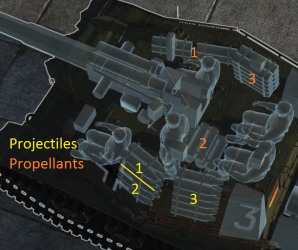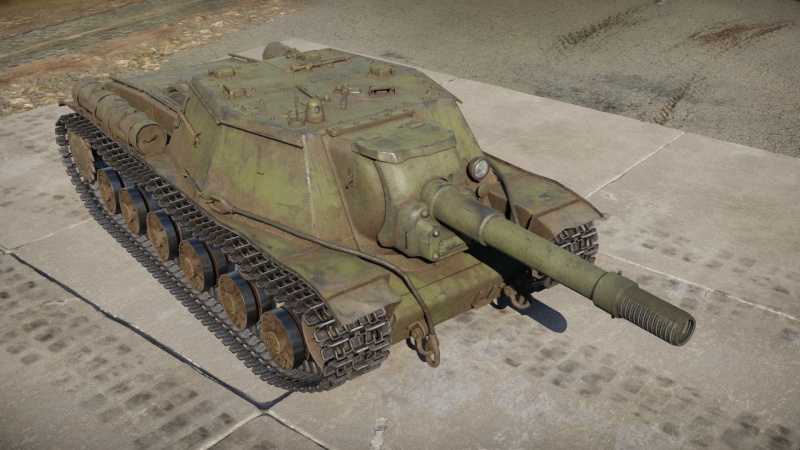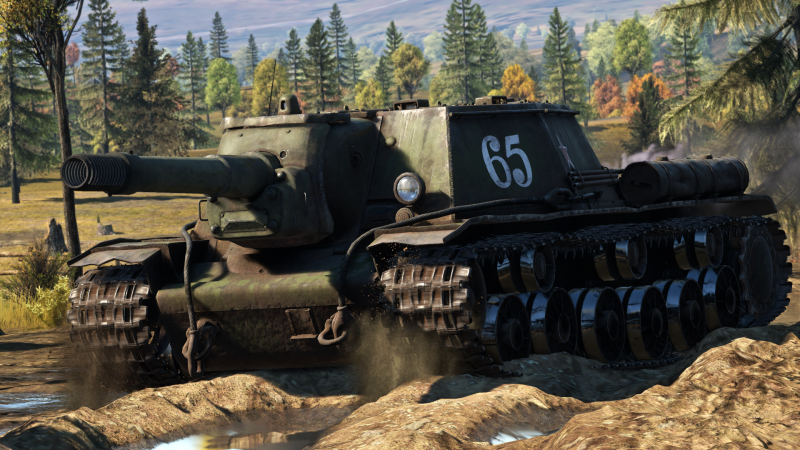SU-152
Contents
Description
The SU-152 is a Soviet self-propelled heavy howitzer used during World War II. Operation Uranus, the counteroffensive against Stalingrad, revealed how desperately the Soviet Army needed mobile heavy firepower to destroy German fortifications. The Soviet front-line ground forces lacked the firepower to destroy pillboxes and other fortifications. During this period, most Soviet howitzers and heavy guns were towed rather than self-propelled. Since towed guns were frequently pulled by horses or their crews, they were susceptible to counterattacks while travelling. The development of the SU-152 began when Soviet engineers installed a 152 mm ML-20S howitzer on a KV-1S heavy tank chassis. It was dubbed Zveroboy, which translates to "beast slayer", due to its impromptu role as a heavy tank destroyer that could take out heavy German armoured vehicles.
Introduced in the Closed Beta Test for Ground Forces before Update 1.41, the SU-152 is a tank destroyer that can serve many different purposes. Since most of the enemy at this point is heavily armoured, armour-piercing shells are the recommended ammunition of choice for engagement. However, in combat, high-explosive shells remain a viable option, particularly when targeting lightly armoured vehicles. However, as this vehicle takes a very long time to reload, players must make sure every shot counts.
General info
Survivability and armour
The SU-152 has decent protection for a tank destroyer, but still is inadequately-protected against any enemy projectiles. The vehicle is armoured mainly with 60 mm of rolled homogeneous armour (RHA), covering the sides, back and glacis. The only thicker armour section covers the gun mantlet and corresponding front plate, armoured with 65 mm of cast homogeneous armour and 75 mm of RHA, respectively. The top of the vehicle is armoured with 20 mm of RHA, meaning that most cannon-calibre aircraft projectiles will penetrate it with ease.
In terms of survivability, the SU-152's five crew members are relatively spaced out, meaning that the chances of an instant crew-knock are smaller. However, the main weakness in the SU-152's protection are it's ammo racks. The vehicle has two large ammo racks (shells on the left side, charges on the right side) that sit directly underneath the side 60 mm RHA belts. This means that any shot that penetrates the side of the hull will likely cause an ammo rack detonation. The engine is located at the very rear of the vehicle, covered by fuel tanks.
Armour type:
- Rolled homogeneous armour
- Cast homogeneous armour
| Armour | Front | Sides | Rear | Roof |
|---|---|---|---|---|
| Hull | 60 mm (32-71°) Front glacis 60 mm (23°) Lower glacis |
60 mm | 60 mm (8-59°) | 30 mm |
| Superstructure | 75 mm (29-30°) Front glacis 65 mm (0-73°) Gun mantlet |
60 mm (22-25°) | 60 mm (11°) | 20 mm |
Notes:
- Suspension wheels are 20 mm thick while tracks are 30 mm thick.
- A 25 mm plate covers front joint area between the front and lower hull glacis.
Mobility
| Game Mode | Max Speed (km/h) | Weight (tons) | Engine power (horsepower) | Power-to-weight ratio (hp/ton) | |||
|---|---|---|---|---|---|---|---|
| Forward | Reverse | Stock | Upgraded | Stock | Upgraded | ||
| Arcade | Expression error: Unexpected * operator. | 852 | Expression error: Unexpected round operator. | __.__ | |||
| Realistic | 531 | Expression error: Unexpected round operator. | __.__ | ||||
The SU-152's mobility isn't particularly impressive. It can reach a top forward speed of 43 km/h, while a lower top speed can be expected in practice, especially when crossing rough terrain. Note that the engine upgrades will dramatically increase the engine horsepower, from 531 to 600 hp for RB and from 852 to 1,150 hp in AB. This means that a fully upgraded SU-152 will perform much better in terms of power, acceleration and off-road capacity. The tank also has relatively good reverse speeds (~17 km/h), much more than Soviet tanks such as the T-34 series. The power-to-weight ratio is also competitive, but should not be relied on.
Modifications and economy
Armaments
Main armament
The SU-152 carries, as the vehicle name suggests, a massive 152 mm gun. The gun has a massive 20+ second reload time, and packs a similarly-massive punch. The ML-20S is a Soviet WWII-era howitzer, developed from a WWI-era howitzer. The weapon can fire an extremely powerful APHE shell with 170 mm of penetration, while still packing 740 grams of TNT filler. The tank can also fire HE shells with 5.9 kg of explosive, as well as an APHEBC shell with more TNT filler. Thus, the shells can easily penetrate the frontal armour of most medium and heavy tanks at the SU-152's BR. In particular, the APHE/APHEBC shells can come as a nasty surprise, as they pack an impressive punch combined with strong penetration ability.
| 152 mm ML-20S | Turret rotation speed (°/s) | Reloading rate (seconds) | |||||||||||
|---|---|---|---|---|---|---|---|---|---|---|---|---|---|
| Mode | Capacity | Vertical | Horizontal | Stabilizer | Stock | Upgraded | Full | Expert | Aced | Stock | Full | Expert | Aced |
| Arcade | 20 | -3°/+20° | ±12° | N/A | 7.0 | 9.8 | 11.8 | 13.1 | 13.9 | 27.69 | 24.50 | 22.58 | 21.30 |
| Realistic | 4.8 | 5.6 | 6.8 | 7.5 | 8.0 | ||||||||
Ammunition
| Penetration statistics | |||||||
|---|---|---|---|---|---|---|---|
| Ammunition | Type of warhead |
Penetration @ 0° Angle of Attack (mm) | |||||
| 10 m | 100 m | 500 m | 1,000 m | 1,500 m | 2,000 m | ||
| BR-540 | APHE | 170 | 169 | 161 | 152 | 144 | 136 |
| OF-540 | HE | 49 | 49 | 49 | 49 | 49 | 49 |
| BR-540B | APHEBC | 171 | 169 | 160 | 150 | 141 | 132 |
| Shell details | ||||||||||||
|---|---|---|---|---|---|---|---|---|---|---|---|---|
| Ammunition | Type of warhead |
Velocity (m/s) |
Projectile mass (kg) |
Fuse delay (m) |
Fuse sensitivity (mm) |
Explosive mass (TNT equivalent) (g) |
Ricochet | |||||
| 0% | 50% | 100% | ||||||||||
| BR-540 | APHE | 600 | 48.78 | 1.2 | 19 | 739.2 | 47° | 60° | 65° | |||
| OF-540 | HE | 655 | 43.56 | 0.3 | 0.1 | 5,860 | 79° | 80° | 81° | |||
| BR-540B | APHEBC | 600 | 48.96 | 1.2 | 19 | 739.2 | 48° | 63° | 71° | |||
Ammo racks

| Full ammo |
Ammo type |
1st rack empty |
2nd rack empty |
3rd rack empty |
Visual discrepancy |
|---|---|---|---|---|---|
| 20 | Projectiles Propellants |
17 (+3) 17 (+3) |
11 (+9) 11 (+9) |
1 (+19) 1 (+19) |
No |
Notes:
- Shells disappear when all shells in the racks have been fired or loaded.
- The SU-152 uses two-piece ammunition, composed of projectiles (yellow) and propellant bags (orange). Both have separate racks.
Usage in battles
The SU-152 is a tank destroyer that serves many different purposes; the most accurate way to observe this vehicle is as somewhat of a "big brother" to the SU-122 and as the "cousin" of the KV-2. However, this vehicle features many differences from its closest predecessors. For example, the SU-152's BR is higher without any noticeable gain in firepower over its relatives. This presents a problem as the SU-152 will no longer be able to perform its trademark knock-outs with one hit thanks to the high-explosive rounds as often. However, unlike the other vehicles that fill the same role, the SU-152 gains access to highly effective armour piercing high explosive (APHE) ammo. This is the pinnacle of the SU-152's effectiveness. Nonetheless, turret shots with HE shells are still a viable option in combat. Due to the vehicle's BR, players are more likely to know and counter your strategy. Thus, the 152's new armour piercing rounds may come as a rude surprise.
The biggest threats you will encounter at any point whilst playing the SU-152 are enemy tank destroyers. The dreaded Panzer IV-derived tank destroyers pose a significant threat; they can punch through the SU-152's armour at ranges of more than 1,000 m with the L70 gun while remaining at the extreme edge of your own effective firing range. Another frequent threat are the M10 and M18 tank destroyers. Boasting both range and speed, these machines can either destroy you from distances that you cannot hope to match or completely avoid your fire while still creeping closer. The final threat to this TD is actually centred on the vehicle itself: an extremely long reload time that leaves little room for error. One missed shot from within your enemy's effective firing range can mean your undoing.
Pros and cons
Pros:
- Makes up for speed with great turning time when stopped
- Powerful HE shells
- Impressive armour piercing damage
- High penetration on AP shells
- Generally good armour
- Good off-road manoeuvrability
- Lowest profile of all of the 152 mm-armed tanks, allows for limited stealth
- Great reverse speed (18 km/h)
Cons:
- Sluggish at low speeds
- Armour is box-like which prevents bounces and includes several shot traps at the front
- It lacks the "fear factor" normally associated with the KV-2
- Reload is long, though not as bad as the KV-2
- Extremely slow vertical guidance speed prevents reaction shots
History
Development
During Operation Uranus, when the Soviet Army was able to successfully encircle the German Sixth Army inside Stalingrad, there were some weaknesses pointed out in their armoured formations. One was the need for heavy guns that could also be mobile, as there were many German fortifications that were unable to be handled by the front-line troops. The Soviet heavy artillery at the time, the 152 mm howitzer, was very heavy and could not be effectively towed from place to place due to unsuitable terrain and lack of capable transportation. Though they experimented with a propelled version of the gun with the KV-2, the tank was phased out of production by October 1941. In November 1942, the State Defense Committee attempted to fix this by ordering the development of a heavy self-propelled gun with the 152.4 mm ML-20 howitzer as its main armament and was to have greater mobility, armour, and better production cost.
The development of this project had actually been going on for a while and was considered before the order for its development, but the SU-152 was cancelled due to the urgency of standard tank production in the war. The project started in December 1942 among three different design teams from different factories. All the designs ended up with the 152 mm howitzer and the utilization of the KV-1S chassis. After evaluations, the design from Josef Kotin was chosen for further development and production as it had the gun and chassis combined with minimum cost. The project was then designated the KV-14 and the first prototype was called "Object 236". The vehicle was complete rather quickly in only 25 days and trials began on January 25, 1943. The vehicle was then approved for production at the Chelyabinsk Kirov Plant on February 14 and accepted into service. The name was changed into its designation SU-152 and was produced from February 1943 to December 1943 with only about 670 units produced.
Design
The design of the SU-152 followed standard Soviet format for self-propelled guns. The fighting compartment was fully armoured in a casemate structure to protect the crew. The crew consisted of four people - the gunner, loader, and commander was positioned beside the gun and the driver near the front. The armour on the SU-152 was about 75 mm on the front and was sloped for better protection. The 152 mm howitzer was mounted slightly to the right of the vehicle and had a limited traverse vector. The SU-152's suspension system was made up of torsion bars from the KV-1 chassis. Observation from inside the vehicle consisted of periscopes on the roof hatches and two gun sights (a panoramic and a telescopic sight). Its communications featured an intercom system installed for use with a single radio plus a radio for communication with other SU-152s. Inside, the crew's armament was made up of a few submachine guns and grenades.
Combat usage
The SU-152 proved devastating in its role, and the first batch was issued to the newly formed heavy mechanized gun regiments in May 1943. The first of these regiments with twelve vehicles saw action in Kursk but was further supplemented with nine more during the battle. The regiments' organization throughout the war was for 21 vehicles in a regiment with three batteries of seven vehicles with one KV-1S tank commanding the regiment. Despite its role as an anti-fortification artillery piece, a role it performed with standard HE rounds, it was also one of the Soviets' best anti-tank weapons. It was classified as a dual-role heavy assault gun and a heavy tank destroyer. Its large cannon could even destroy the new Panthers, Tigers, and Ferdinands with relative ease by utilizing the spalling and blast concussion effects produced by its large high explosive shells. Because of such a capability of the vehicle to destroy better German tanks, it earned its nickname as the Zveroboy, or the "Beast Slayer". The reports of the "SU-152 effect" on target is said to have been able to take the turret off the Tiger I at any range with just the HE shell. The SU-152 was reported to have caused numerous armoured fighting vehicle losses to the German side. One commander, Major Sankovskiy, who commanded a SU-152 that destroyed ten German tanks in one day, was awarded the Hero of the Soviet Union.
After Kursk, the SU-152 continued to serve as the Soviet Army's primary anti-fortification weapon in all of its front lines, especially during its Operation Bagration offensive in summer of 1944. However, production ended in December 1943 and thus combat losses caused a decrease in SU-152 quantity in Soviet inventory. This halt in the production was due to the introduction of the better armoured and more reliable ISU-152, which was based on the newer IS-2 heavy tank while still keeping the same gun and combat role. Despite that, the SU-152 remained in service until 1954, when the Soviets decommissioned, scrapped, or sold their remaining SU-152s to other allies such as Syria and Egypt.
| Archive of the in-game description | |
|---|---|
|
This SPG was put into production and service in February 1943. It holds a unique record in that the design and construction of its prototype model took only 25 days. The vehicle was created based on the KV-1S tank. The powerful 152 mm ML-20 howitzer-gun's elevating mass with a 28.8 calibre barrel length was installed practically unaltered in its frame. Its crew of five were housed in a specially designed fighting compartment. The vehicle's hull and cabin were welded from rolled armour plates of 20, 30, 60 and 70 mm thickness. The gun mantlet was 60 mm thick. Its direct firing range came to 3,800 m, and its maximum range was 6,200 m. The howitzer-gun's rate of fire was 2 shots per minute. The vehicle's ammunition complement consisted of 20 separate loading quick-fire shells. The self-propelled gun was mass-produced in February-December 1943. In total, 670 of them were made. The SU-152 turned out to be a very effective means to combat heavy tanks. These vehicles' shells, weighing 48.8 kg each, easily penetrated Tiger and Panther armour and ripped off their turrets. This lead front-line soldiers to affectionately dub it Zveroboy (one who fights beasts/animals). Thanks to its combination of mobility and high firepower, the SU-152 was used in three separate roles: assault weapon, tank destroyer and self-propelled howitzer. However, the weapon's low rate of fire and elevation angle along with its closed fighting compartment significantly hampered the vehicle's effectiveness. The SPG's other disadvantages were the absence of a defensive machine gun, its insufficient frontal armour for 1943 and its crowded fighting compartment. The lack of forced draught ventilation in the fighting compartment, particularly when the engine stalled, often lead to the crew suffocating during firing operations. | |
Media
- Skins
- Videos
See also
- Related development
External links
| Chelyabinsk Tractor Plant (Челябинский тракторный завод) | |
|---|---|
| IFVs | |
| BMP-1 | BMP-1 |
| Heavy Tanks | |
| KV | KV-85 · KV-122 |
| IS-1/2 | IS-1 · IS-2 · IS-2 (1944) · IS-2 "Revenge" · IS-2 No.321 |
| T-10 | T-10A · T-10M |
| Other IS Tanks | IS-3 · IS-4M |
| Tank Destroyers | |
| KV Derivatives | SU-152 |
| IS Derivatives | ISU-152 · ISU-122 · ISU-122S · Object 268 |
| Export | |
| IS-2 | ␗IS-2 · IS-2 No.402 · ␗IS-2 (1944) |
| ISU | ␗ISU-152 · ␗ISU-122 |
| IFVs | SPz BMP-1 |
| See Also | Leningrad Kirov Plant |
| USSR tank destroyers | |
|---|---|
| SU-76M | SU-76M · SU-76M (5th Gv.Kav.Corps) · SU-85A |
| SU-57B | SU-57B · SU-76D |
| T-34 Derivatives | SU-122 · SU-85 · SU-85M · SU-100 · SU-122P |
| Heavy Tank Derivatives | SU-100Y · ISU-122 · ISU-122S · SU-152 · ISU-152 · Object 268 |
| SU-100P and Derivatives | SU-100P · Object 120 |
| Wheeled | YaG-10 (29-K) |
| Airborne | ASU-57 · ASU-85 |
| Rocket | BM-8-24 · BM-13N · BM-31-12 |
| ATGM | IT-1 · Shturm-S · Object 775 · Khrizantema-S |
| Artillery | 2S1 · 2S3M |
| Other | SU-5-1 · ZiS-30 · SU-122-54 |
| USA | SU-57 |






